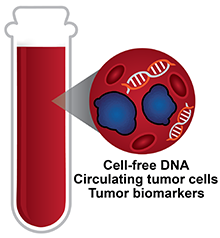Liquid Biopsy Success Stories
 The ability to use a simple blood draw to develop a relatively non-invasive test for not only detecting the presence of cancer in a patient, but also determining the optimal treatment strategy is one of the white whales of cancer research. Seeking, validating, and clinically implementing markers that allow the ability to draw such conclusions from small samples of a patient’s blood is the focus of liquid biopsy technologies. Using liquid biopsies for monitoring a patient’s response to therapy or early signs of recurrence are possibilities that are already being practiced in clinics today. Listed below are examples of technologies supported by the IMAT program to enable an early detection and monitoring capability for cancer.
The ability to use a simple blood draw to develop a relatively non-invasive test for not only detecting the presence of cancer in a patient, but also determining the optimal treatment strategy is one of the white whales of cancer research. Seeking, validating, and clinically implementing markers that allow the ability to draw such conclusions from small samples of a patient’s blood is the focus of liquid biopsy technologies. Using liquid biopsies for monitoring a patient’s response to therapy or early signs of recurrence are possibilities that are already being practiced in clinics today. Listed below are examples of technologies supported by the IMAT program to enable an early detection and monitoring capability for cancer.
 Liquid Biopsy 1: High-Definition Single Cell Analysis (HD-SCA)
Liquid Biopsy 1: High-Definition Single Cell Analysis (HD-SCA)
“Each cancer today has tens of treatment options and we have over a thousand trials ongoing, there is no choice but to figure out how to manage treatment decisions with a comprehensive liquid biopsy.”
-Peter Kuhn, PhD, University of Southern California
“Nanotechnology-enabled devices for non-invasive cancer detection.”
-Hsian-Rong Tseng, PhD, University of California, Los Angeles
 Liquid Biopsy 3: Magnetic Ranking Cytometry (MagRC)
Liquid Biopsy 3: Magnetic Ranking Cytometry (MagRC)
“Magnetic ranking cytometry allows the quantitative analysis of molecular markers in single circulating tumor cells. This is a powerful capability for liquid biopsy that will allow therapeutic targets to be tracked for treatment selection.”
-Shana Kelley, PhD, University of Toronto


 Liquid Biopsy 2: NanoVelcroTM
Liquid Biopsy 2: NanoVelcroTM